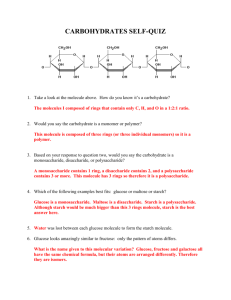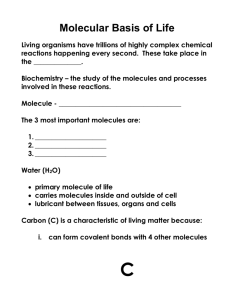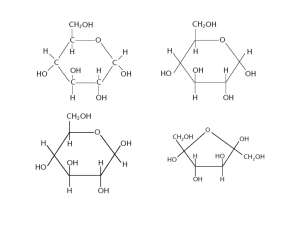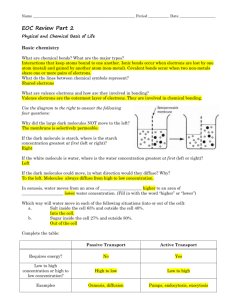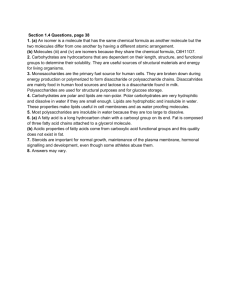Biomolecules / Macromolecule – Carbohydrates A thorough
advertisement
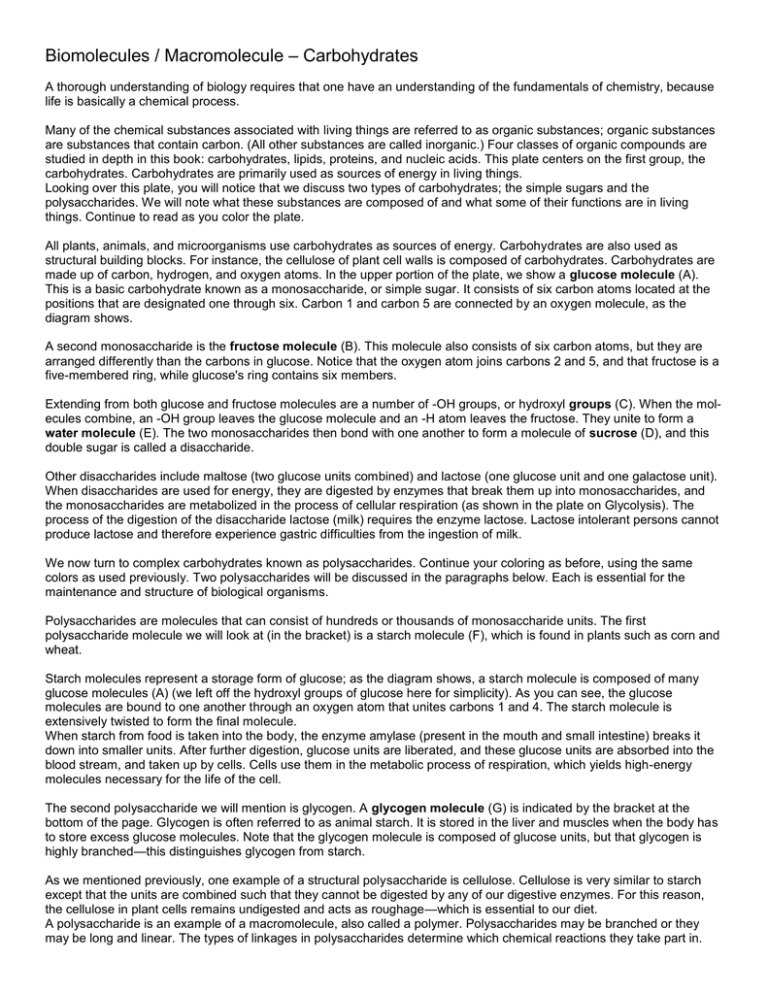
Biomolecules / Macromolecule – Carbohydrates A thorough understanding of biology requires that one have an understanding of the fundamentals of chemistry, because life is basically a chemical process. Many of the chemical substances associated with living things are referred to as organic substances; organic substances are substances that contain carbon. (All other substances are called inorganic.) Four classes of organic compounds are studied in depth in this book: carbohydrates, lipids, proteins, and nucleic acids. This plate centers on the first group, the carbohydrates. Carbohydrates are primarily used as sources of energy in living things. Looking over this plate, you will notice that we discuss two types of carbohydrates; the simple sugars and the polysaccharides. We will note what these substances are composed of and what some of their functions are in living things. Continue to read as you color the plate. All plants, animals, and microorganisms use carbohydrates as sources of energy. Carbohydrates are also used as structural building blocks. For instance, the cellulose of plant cell walls is composed of carbohydrates. Carbohydrates are made up of carbon, hydrogen, and oxygen atoms. In the upper portion of the plate, we show a glucose molecule (A). This is a basic carbohydrate known as a monosaccharide, or simple sugar. It consists of six carbon atoms located at the positions that are designated one through six. Carbon 1 and carbon 5 are connected by an oxygen molecule, as the diagram shows. A second monosaccharide is the fructose molecule (B). This molecule also consists of six carbon atoms, but they are arranged differently than the carbons in glucose. Notice that the oxygen atom joins carbons 2 and 5, and that fructose is a five-membered ring, while glucose's ring contains six members. Extending from both glucose and fructose molecules are a number of -OH groups, or hydroxyl groups (C). When the molecules combine, an -OH group leaves the glucose molecule and an -H atom leaves the fructose. They unite to form a water molecule (E). The two monosaccharides then bond with one another to form a molecule of sucrose (D), and this double sugar is called a disaccharide. Other disaccharides include maltose (two glucose units combined) and lactose (one glucose unit and one galactose unit). When disaccharides are used for energy, they are digested by enzymes that break them up into monosaccharides, and the monosaccharides are metabolized in the process of cellular respiration (as shown in the plate on Glycolysis). The process of the digestion of the disaccharide lactose (milk) requires the enzyme lactose. Lactose intolerant persons cannot produce lactose and therefore experience gastric difficulties from the ingestion of milk. We now turn to complex carbohydrates known as polysaccharides. Continue your coloring as before, using the same colors as used previously. Two polysaccharides will be discussed in the paragraphs below. Each is essential for the maintenance and structure of biological organisms. Polysaccharides are molecules that can consist of hundreds or thousands of monosaccharide units. The first polysaccharide molecule we will look at (in the bracket) is a starch molecule (F), which is found in plants such as corn and wheat. Starch molecules represent a storage form of glucose; as the diagram shows, a starch molecule is composed of many glucose molecules (A) (we left off the hydroxyl groups of glucose here for simplicity). As you can see, the glucose molecules are bound to one another through an oxygen atom that unites carbons 1 and 4. The starch molecule is extensively twisted to form the final molecule. When starch from food is taken into the body, the enzyme amylase (present in the mouth and small intestine) breaks it down into smaller units. After further digestion, glucose units are liberated, and these glucose units are absorbed into the blood stream, and taken up by cells. Cells use them in the metabolic process of respiration, which yields high-energy molecules necessary for the life of the cell. The second polysaccharide we will mention is glycogen. A glycogen molecule (G) is indicated by the bracket at the bottom of the page. Glycogen is often referred to as animal starch. It is stored in the liver and muscles when the body has to store excess glucose molecules. Note that the glycogen molecule is composed of glucose units, but that glycogen is highly branched—this distinguishes glycogen from starch. As we mentioned previously, one example of a structural polysaccharide is cellulose. Cellulose is very similar to starch except that the units are combined such that they cannot be digested by any of our digestive enzymes. For this reason, the cellulose in plant cells remains undigested and acts as roughage—which is essential to our diet. A polysaccharide is an example of a macromolecule, also called a polymer. Polysaccharides may be branched or they may be long and linear. The types of linkages in polysaccharides determine which chemical reactions they take part in.



